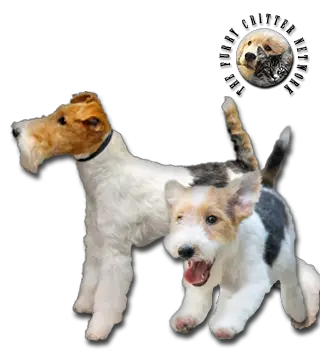Breed Standard
Head: Elongated. Flat skull. Slight stop. Nose bridge tapers toward the nose. Strong jaws covered with a rough coat.
Ears: Small, v-shaped, folded and hanging forward against the cheeks. Erect ear is a disqualification.
Eyes: Small, round. Dark color.
Body: Compact. Muscular neck without dewlap. Clearly pronounced withers. Chest well let down. Ribs moderately sprung. Croup not sloped. Short, horizontal back. Powerful, muscular loin.
Tail: Set high, of fair length, carried gaily but not over the back and not curled. Typically docked.
Hair: Two varieties :Wire hair : Dense, very hard texture, approx. 1,9 cm (0,7 in) long on the shoulders and 3,8 cm (1,5 in) long on the withers, back, sides and hindquarters. Coat on the jaws is very rough. Short, softer undercoat.Smooth hair: straight, flat, smooth, hard, thick and abundant.
Coat: White is the predominant color; solid white, white with tan, black or black and tan markings. Brindle, blue, slate gray, red, or liver markings not permitted.
Size: Dog : 39,3 cm (15,5 in) or less.Bitch : slightly shorter than dog.
Weight: Dog: approx. 8 kg (18 lb).Bitch: approx. 7 kg (16 lb).
History
Not much is known of early 19th century breeding practices that came to create the modern Fox Terrier. However it is thought that the Beagle, Old English Bulldog, English Toy Terrier, Pointer and even Dalmatian were all used in the creation and stabilisation of the breed.
From 1870 onwards, a complete pedigree for Fox Terriers exists. Three dogs, known as Old Jock, Trap and Tartar, are the ancestors of most modern strains of white terrier. Old Jock was bred from a black and tan terrier, while Trap was from the strain out of Reverend John "Jack" Russell's dogs. Russell would later have the Jack Russell Terrier series of breeds named after him. Although definitive history on Tartar is not known, he is also thought to have come from black and tan terrier stock. Of the female dogs from this period, Grove Nettle was the best known. In addition to those dogs, another named Old Tip is thought to be the forefather of the modern Wire Fox Terrier.
The terrier of this period was short of leg, built in a chunky fashion, and had a skull that was broad across the top. Used in hunting packs and kept in kennels along with English Foxhounds, they were bred for their ability to drive the fox out of its den. Gradually the pace of the hunt became faster, and the terriers were bred with longer legs for more speed towards the end of the 18th century. However the increased size meant that the Fox Terrier became too big to be used for its original purpose, and its use in fox hunting began to decline.
The Fox Terrier Club of England was founded in 1876, with the American Fox Terrier Club following nine years later, becoming the first breed speciality club to become a member of the American Kennel Club. A female Smooth Fox Terrier bred by Winthrop Rutherfurd named Warren Remedy was the first winner of Best in Show at the Westminster Kennel Club Dog Show in 1907, 1908, and 1909. Following the popularity of conformation dog shows, the Fox Terrier was the result of selective breeding. For instance, by 1949, 120 of 140 Wire Fox Terrier champions were descended from a single championship-winning dog.
Behavior
This rustic, hardy, fast dog is full of life, always on the move and possesses seemingly boundless energy. Courageous and bold, he has a strong, established personality. He is affectionate with his owners and gentle with children. He is a vigilant guard, barking to raise the alarm. The Fox Terrier is aggressive toward other dogs and therefore has difficulties living with other animals. Firm but gentle training is required.
The Fox Terrier can adapt to life in the city, but he requires considerable exercise to prevent him from becoming excessively nervous. This breed does not like to be tied up or closed in. Weekly brushing is sufficient for the smooth variety. The wire variety requires brushing two or three times per week and professional grooming three times per year.
Function
Hunting Dog, Guard Dog, Pet.
Health
Myasthenia gravis, a neuromuscular disease, is inheritable in the Smooth Fox Terrier through an autosomal recessive gene. This can also be a symptom of megaesophagus, which is a health issue for the Wire Fox Terrier. Another inheritable condition in the Smooth Fox Terrier is cataracts, which is more prevalent than average in the breed. Both types of Fox Terrier can be susceptible to allergies.
In a survey conducted by The Kennel Club, the primary cause of death for Fox Terriers was old age, causing 31.8% of reported deaths. The secondary cause was cancer of an unspecified type, which accounted for 22.7% of reports. The average lifespan of a Fox Terrier is around 15 years; the Kennel Club survey reported a median age at death of 13 years and 2 months.






